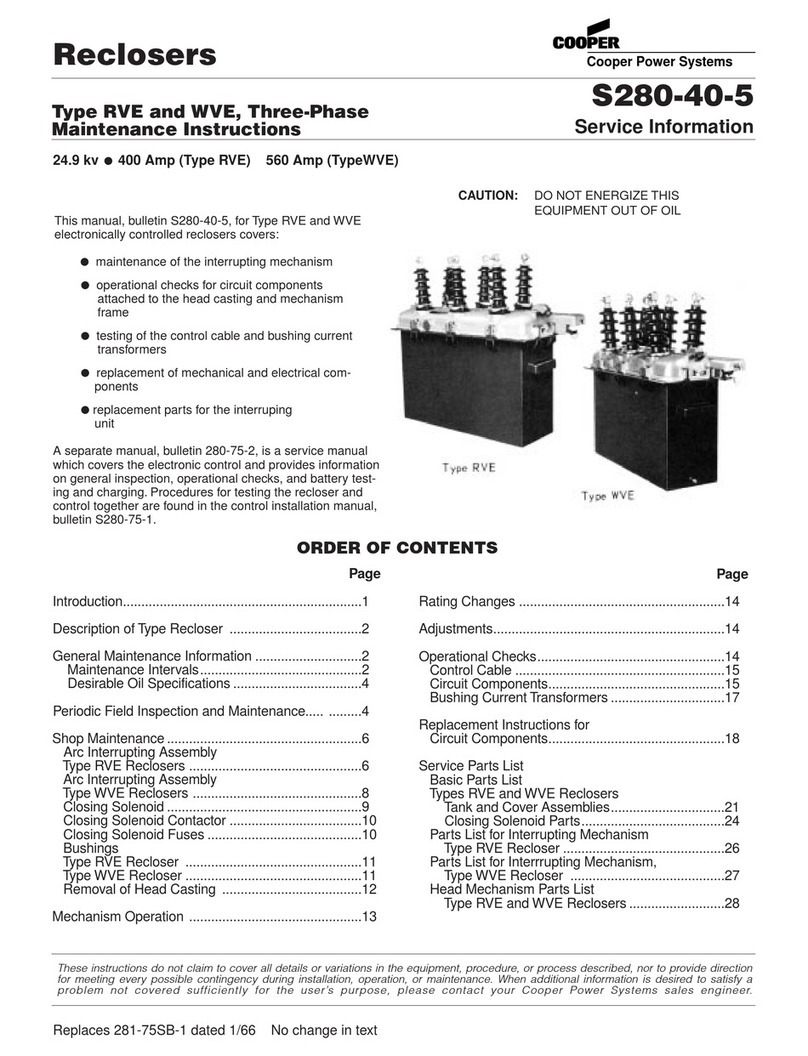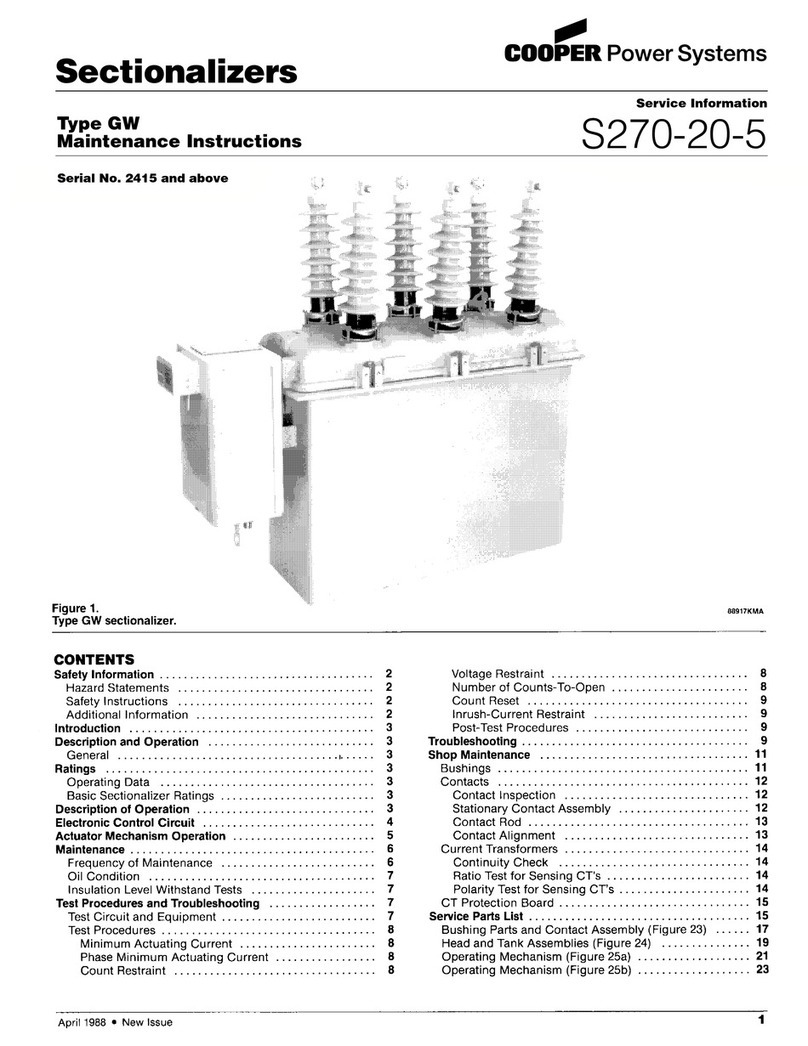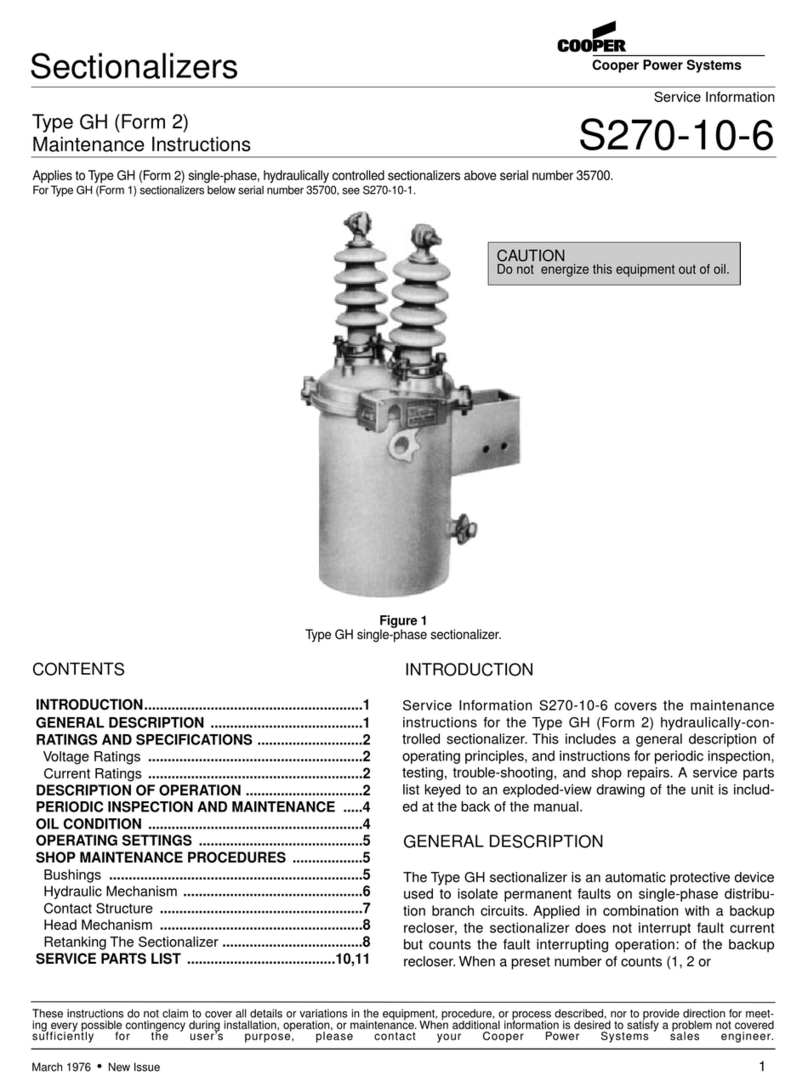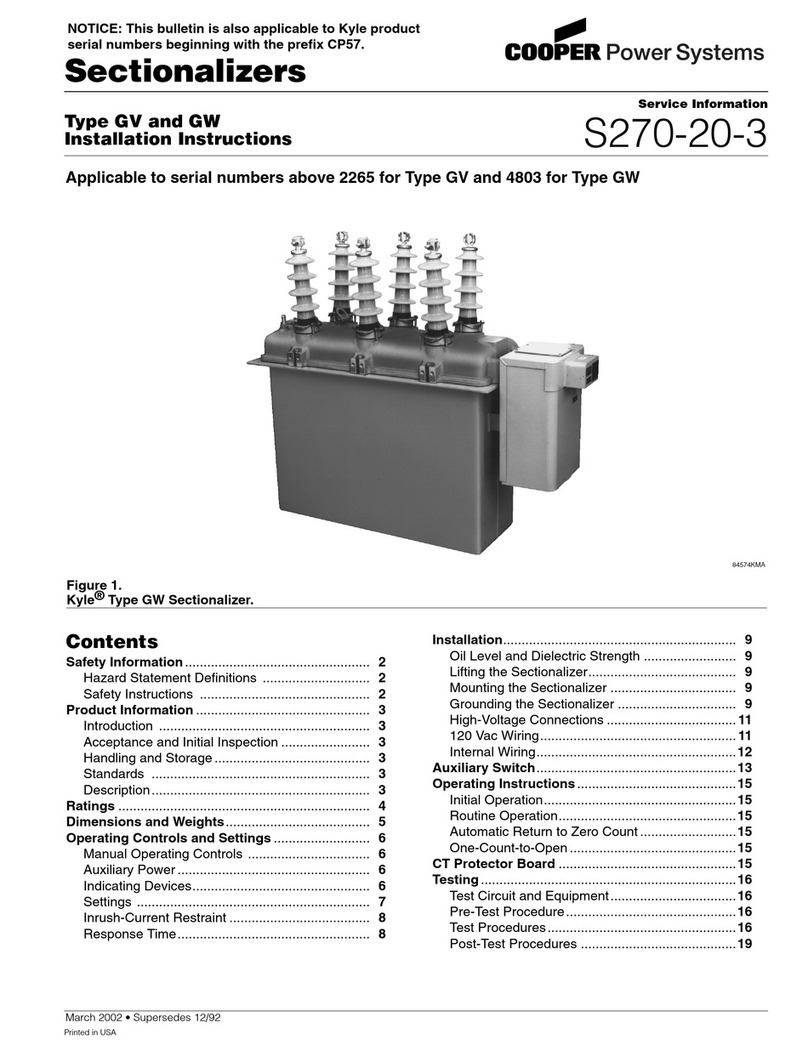
8
Type GV Maintenance Instructions
interruption. The reset time settings have a tolerance of ±
10 percent. It can be verified by interrupting an overcurrent
flow through the sectionalizer one time less than the counts-
to-open setting, then allowing load current to flow for peri-
ods just under and just over the reset setting. The sectional-
izer should open if the overcurrent for the final count is
interrupted within the reset time period (reset has not acti-
vated). The sectionalizer should not open if the over current
for the final count is interrupted after the reset time period
(count has reset to zero). The following procedure may be
used to verify the count reset.
1. Jumper the ground actuating current resistor with a
short lead to disable ground sensing circuit.
2. Program sectionalizer control for 2 COUNTS-TO-OPEN
and set the COUNT RESETSELECTOR to 15 seconds.
3. Close sectionalizer by operating close pullring the
required number of times.
4. With test circuit connected to phase A of the sectionaliz-
er and S1 open, close S2 and raise the test current to
slightly above the appropriate value shown in Column
B of Table 1.
5. Release S2 to simulate a backup protective device
clearing the overcurrent. The sectionalizer will register
a count.
6. Close S1 for 13.5 seconds.
7. Momentarily close and then release switch S2. The sec-
tionalizer should open, verifying that the count reset
has not been activated.
8. Reclose sectionalizer and then close and release S2
once to register one overcurrent interruption count.
9. Close S1 for slightly more than 22 seconds.
10. Momentarily close and release switch S2. The section-
alizer should not open verifying that the count reset has
been activated and the first count has been erased.
11. Again close and release S2. The sectionalizer should open.
INRUSH-CURRENT RESTRAINT
The inrush-current restraint feature distinguishes between fault
currents and inrush currents. For fault current interruptions, the
sectionalizer counts and opens normally. For an inrush-current
condition, the phase minimum actuating current is raised by a
preset multiple for a preset time and ground fault detection is
blocked for a preset time to prevent counting the inrush current.
The operation of the inrush-current restraint can be verified by
simulating a fault condition (the overcurrent is preceded by an
overcurrent interruption) and an inrush condition (the overcur-
rent is preceded by a load current interruption). The following
procedure may be used to verify the inrush current restraint
feature.
1. Jumper the ground actuating current resistor with a short
lead to disable the ground sensing circuit.
2. Set the COUNTS-TO-OPEN SELECTOR switch to “1”
and the PHASE ACTUATING LEVEL MULTIPLIER
switch to X2.
3. Set the GND INRUSH RESET and the PHASE INRUSH
RESET switches to TEST.
NOTE: In the TEST position, the inrush restraint is blocked from
resetting once it is activated.
4. Close sectionalizer by operating close pullring the
required number of times.
5. With test circuit connected to phase A of the sectionalizer
and S1 open, hold S2 closed and raise the test current to
slightly below the appropriate value shown in Column A
of Table 1.
6. Release S2 to simulate a backup opening with only load
current flowing through the sectionalizer when current
was interrupted. The sectionalizer should not open.
7. Close S2 and adjust the test current to just below twice
the appropriate value shown in Column A of Table 1 to
simulate an inrush condition.
8. Release S2. The sectionalizer should not open, verifying
that the inrush restraint feature has been activated.
9. Reset inrush restraint as follows:
A. Return the GND INRUSH RESET and the PHASE INRUSH
RESET switches to some finite values.
B. Hold S2 closed longer than the greater of the two settings
to reset the inrush restraint feature.
C. Return both GND INRUSH RESET and PHASE INRUSH
RESET switches to TEST.
10. Again hold S2 closed and raise the test current to slightly
below the appropriate value shown in Column A of Table 1.
11. Release S2 to simulate a backup opening with only load cur-
rent flowing through the sectionalizer when current was inter-
rupted.
12. Close S2 and adjust the test current to slightly twice the value
shown in Column B of Table 1.
13. Release S2. The sectionalizer should trip verifying the 2X
phase actuating level multiplier setting.
14. Manually close the sectionalizer and repeat step 9 to reset the
inrush restraint feature.
15. Close S2 and raise the test current to slightly above the
appropriate value shown in Column B of Table 1.
16. Release S2 to simulate a backup opening with fault current
flowing through the sectionalizer when current was interrupt-
ed. The sectionalizer should open.
17. Close the sectionalizer.
18. Repeat step 15 to simulate a fault condition.
19. ReleaseS2.The sectionalizer should open verifying that the
inrush restraint feature has not been activated.
Post-Test Procedures
After testing has been completed, make sure the control settings
are programmed to the operating parameters as originally
specified.
TROUBLESHOOTING
Sectionalizer troubleshooting is the process of evaluating prob-
lems that are encountered and determining the cause. The fol-
lowing procedure is recommended.
1. Check for loose or broken connections and wiring. Figure 10
shows the interconnection between the various electrical com-
ponents of the sectionalizer.
2. Check the toggle and associated linkage and springs for
mechanical binding by closing the sectionalizer and tripping it
manually several times.
3. Perform the applicable electrical test described in the Test
Procedures section of these instructions. If the sectionalizer
does not trip under test either the control or the bi-stable actua-
tor assembly may be malfunctioning.
A. Check the bi-stable actuator assembly to see if it has—or has
not—released.
NOTE: There should be approximately 1/32-in. play between the end
of the trip rod and the lever assembly on the main shaft (Figure 13).
(1 ) If the bi-stable actuator assembly actuated the toggle
assembly should be released. If the malfunction is the
result of mechanical binding of the toggle orthe associated
linkages check the engagement surface of the toggle to
make sure there are no rough spots or burrs. Repair as
required.
(2) If the bi-stable actuator assembly did not actuate, check
the d-c resistance of the trip coil:
With the red and the brown leads removed from the con-
trol circuit board the resistance should measure approxi-
mately 6.5 ohms.
If the bi-stable actuator assembly is damaged or
inoperative it must be replaced. Make sure there is
approximately 1/32-in. play between the end of the
































